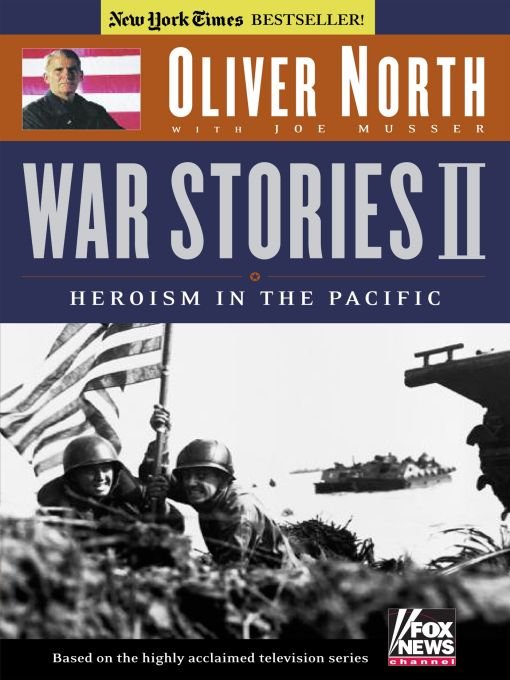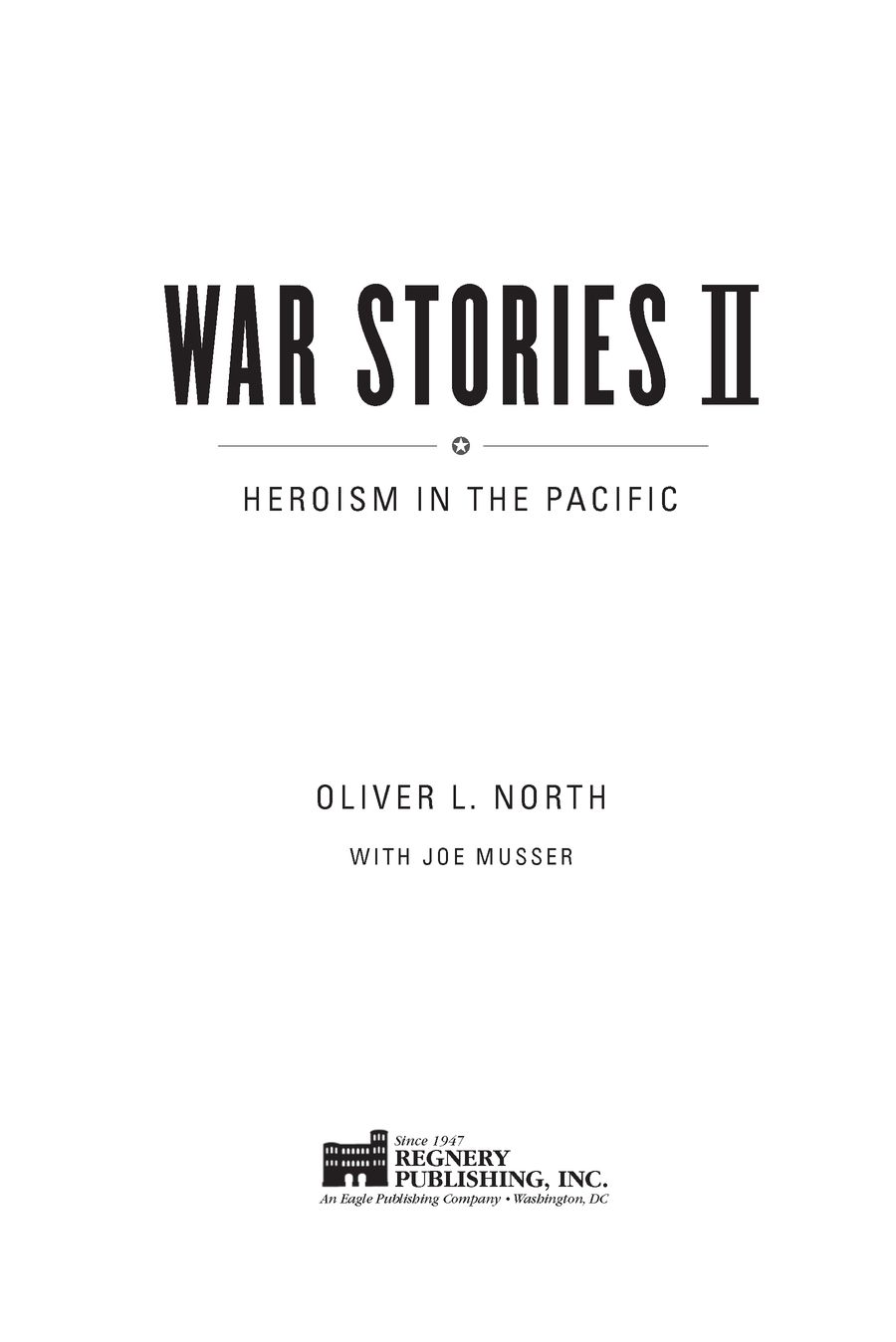War Stories II
Authors: Oliver L. North



Table of Contents
Â
Â
Â
Â
Â
Â
Â
Â
Â
Â
Â
Â
Â
Â
Â
Â
Â
Â
Â
Â
To those who serve nowâ¦
With gratitude to those who served thenâ¦
That we all might live in freedom tomorrow.
With gratitude to those who served thenâ¦
That we all might live in freedom tomorrow.
PREFACE
PRELUDE TO THE WAR IN THE PACIFIC
(
1930-1941 )
1930-1941 )
 PEARL HARBOR, HAWAII
PEARL HARBOR, HAWAIISUNDAY, 21 MARCH 2004
0800 HOURS LOCAL
0800 HOURS LOCAL
F
or Americans, World War II began here on a Sunday morning not much different from this one. The air is clear and crisp. Puffy white clouds punctuate the blue sky, and the sun, still low on the horizon, is already bright. A bugle sounds the notes for colors, and ashore, off in the distance, a church bell summons people to worship. This morning, here on the waters of Pearl Harbor, naval ensigns flutter from their halyards in a light breeze as sailors go about their duties on the decks of haze-gray Navy hulls. These are sights and sounds that would have been impossible to see or hear at this hour on 7 December 1941.
or Americans, World War II began here on a Sunday morning not much different from this one. The air is clear and crisp. Puffy white clouds punctuate the blue sky, and the sun, still low on the horizon, is already bright. A bugle sounds the notes for colors, and ashore, off in the distance, a church bell summons people to worship. This morning, here on the waters of Pearl Harbor, naval ensigns flutter from their halyards in a light breeze as sailors go about their duties on the decks of haze-gray Navy hulls. These are sights and sounds that would have been impossible to see or hear at this hour on 7 December 1941.
Every time I have visited Pearl Harbor I have tried to imagine what it must have been like at 0755 that Sabbath morn as 183 Japanese planes, led by Commander Mitsuo Fuchida, came roaring in on the first wave of the surprise attack. Even though the USS
Ward,
an aging World War Iâera
destroyer, had fired upon and sunk a two-man midget submarine just outside the harbor an hour before the air assault began, the Japanese pilots approached unchallenged. The dive-bombers struck first, taking out most of the land-based aircraft on Ford Island, as well as Ewa, Wheeler, Bellows, Kaneohe, and Hickam Fields. Two minutes later, torpedo bombers swept in low and fastâthe first wave hit every outboard capital vessel tethered on Battleship Row. The venerable USS
Arizona,
tied up beside the USS
Vestal,
a repair ship, had already been struck by aerial torpedoes when a Japanese bomb plunged into the forward fourteen-inch powder magazine. The resulting explosion sent the ship and 1,102 men to the bottom before the attack was five minutes old.
Ward,
an aging World War Iâera
destroyer, had fired upon and sunk a two-man midget submarine just outside the harbor an hour before the air assault began, the Japanese pilots approached unchallenged. The dive-bombers struck first, taking out most of the land-based aircraft on Ford Island, as well as Ewa, Wheeler, Bellows, Kaneohe, and Hickam Fields. Two minutes later, torpedo bombers swept in low and fastâthe first wave hit every outboard capital vessel tethered on Battleship Row. The venerable USS
Arizona,
tied up beside the USS
Vestal,
a repair ship, had already been struck by aerial torpedoes when a Japanese bomb plunged into the forward fourteen-inch powder magazine. The resulting explosion sent the ship and 1,102 men to the bottom before the attack was five minutes old.
By 0945, when the second wave of Japanese attackers finished spewing death and destruction from bombs, torpedoes, machine guns, and 20 mm cannon fire, 2,403 Americansâmilitary and civilianâwere dead or dying, and 1,178 others had been wounded. Of the ninety-six warships at Pearl Harbor, eighteen had been sunk or severely damaged. Five of the eight Pacific Fleet battleships, the U.S. Navy's primary strike force, were on the bottom or out of commission. Of the 388 Army, Navy, and Marine aircraft based in Hawaii, 199 had been damaged or destroyed and fewer than a hundred were left usable. As the Americans tended the wounded, fought fires, rescued shipmates, and tried to salvage sinking vessels, six Japanese carriers 200 miles north of Oahu recovered their aircraft and turned back westâescaping unscathed. Only twenty-nine of Fuchida's pilots failed to return.
The U.S. soldiers, sailors, airmen, and Marines in Hawaii were not the only Americans to fight the Empire of Japan on this “day of infamy.” That evening, the Japanese struck our bases and facilities on Guam, on Wake Island, and in the Philippines. British and Dutch forces were assaulted in Hong Kong and Malaya. And on 8 December, while Congress debated a resolution to declare war, the Imperial Navy attacked Midway. These coordinated attacks, part of a master plan reluctantly devised by Fleet Admiral Isoroku Yamamoto, commander in chief of the Japanese Combined Fleet, were deemed in Tokyo to be a stunning military success.
But Pearl Harbor became something else that the emperor and most of his ambitious generals and admirals could not foresee as they celebrated their short-lived victory. Until the Japanese surrender in Tokyo Bay on 14 August 1945, Americans from every walk of life and every ethnic background would be motivated to serve in uniform, work harder, eat less, volunteer more, and buy war bondsâall with the rallying cry “Remember Pearl Harbor!”

As a boy I had read about that “day of infamy,” seen the pictures and newsreels, and later studied it at the Naval Academy. Then I visited this hallowed place while commuting to and from other wars. But it wasn't until I began interviewing those who were young men and women on 7 December 1941 that I began to grasp what that day was really like and what it meant to a generation of Americans. More than six decades after the event, every one of these warriors and their contemporaries, no matter where they were at the time, can recall exactly what they were doing and who they were with when they learned about the surprise attack on Pearl Harbor.
Other books
Feather Brain by Maureen Bush
Mana in the Modern World non illustrated version by R. McCullough
La paciencia de la araña by Andrea Camilleri
Badass Zombie Road Trip by Tonia Brown
Last Call by Brannon, M.S.
Vigilante by Sarah Fine
The Sorcerer's Scourge by Brock Deskins
Sailors on the Inward Sea by Lawrence Thornton
Cowboy Jackpot: St. Patrick's Day by Randi Alexander
The Opposite of Love by Sarah Lynn Scheerger
